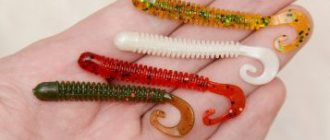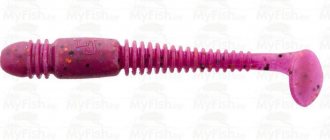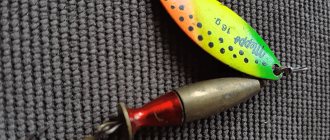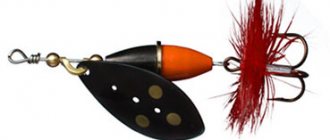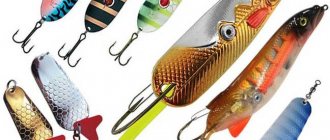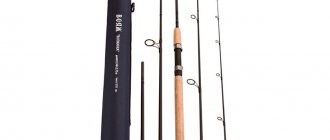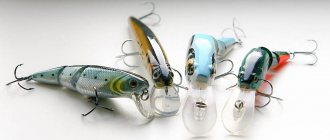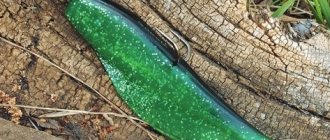Silicone lures for pike, types and their features
Silicone bait imitates small fish or other inhabitants of a reservoir, which a predator instinctively attacks, even if it is full. A wide range and affordable prices of silicone baits allow you to choose several models at once. Typically, a spinning angler has a selection of baits that vary in size, color, softness and edibility. This variety ensures the choice of the right bait to ensure effective fishing, since pike changes its taste preferences at different times.
There are several types of silicone baits:
Twisters
The shape of the twister is cylindrical and slightly elongated. The surface is embossed, reminiscent of a larva or fish. Also on its body there may be various processes that imitate the legs of an insect. There are one or two crescent-shaped tails at the end. They simulate frog legs.
A hook is installed in the body of the twister. Body size 5-10 cm, diameter about 1-1.5 cm.
When the bait is in the water, it sways and with these movements attracts pike.
Vibrotails
Rubber lures for pike of this type consist of a body and a tail. Vibrotails (or silicone fish, as many call them) can have a different body shape, which can be narrow-bodied or tall-bodied (more voluminous). The surface is smooth or ribbed. There is a flat extension at the end of the thin tail. This shape is also called hoof-shaped. While in the water, the tail vibrates. The size of the “hoof” is different and the larger it is, the more it vibrates and attracts a predator.
The vibrotail imitates a small fish that a predator likes to feed on.
Slugs
Slugs are a bait that has an oblong body shape and imitates a fish fry. It may taper at the end and be covered with ribbed half rings. Made from soft silicone and can be impregnated with fragrance.
This type of bait is of the passive type. While in the water, it does not produce vibrating movements. The fisherman himself must change the speed of reeling in the reel and manipulate the tip of the spinning rod to create movement of the bait.
Slugs are mounted on an offset or single hook using a hinged mounting. The bait is used in drop-shot, retractable liner and Texas equipment.
Worms
A popular bait for various styles of spinning and microjig fishing. Can imitate a worm, large bloodworm, leech. Typically made from soft silicone. The shape is elongated and may have narrowings and thickenings in various parts. The size varies from small to larger: 10-20 cm with a thickness of at least 7 mm. The silicone worm is equipped with an offset or ordinary hook. They are mounted hingedly, and a small weight Cheburashka weight is added. Or they use a lead leader, a split shot and a Carolina rig.
About
Wiring silicone jig baits
Date: March 20, 2021 | 412
I am sure that at least somewhat experienced spinning anglers understand that wiring and the style of presenting the bait greatly influences the effectiveness of fishing. When fishing with modern soft baits, edible silicone, this rule also applies. It is very rare that banal uniform wiring in the upper layers of water, as beginners do, brings at least some result. So let's talk about which wiring is best for different types of silicone baits, which wiring techniques are best for perch, pike, pike perch and other popular fish species.
Any bait animation of any value is heterogeneous, consisting of different phases. Remember this very well! No matter what class of spinning tackle you use, from heavy jig to ultralight, no matter what type of bait you use, it is very rare when a simple even retrieve gives a good result. If you manage to catch fish on it, it is mainly pike at peak activity. And even then, if you include other elements in the uniform wiring, it will only be better. Moreover, significantly!
Perhaps the only exception is fishing with rotating spoons in shallow streams with a rocky bed. There really is no time for pauses here, and stretching and acceleration do not make sense. But on the pages of this blog we talk mainly about fishing with silicone baits and jigs. And here, the rule of various postings always works.
Well, I will divide this material into two parts. First, I will consider a number of the most popular elements of silicone bait wiring, which make up the complete pattern of its presentation to the fish. In the second part, I will try to describe examples of effective fishing for different types of fish (perch, pike, pike perch, etc.). At a minimum, I’ll tell you what wiring I use. Let's get started.
Uniform wiring.
You cast the bait, give it a pause so that it sinks to the bottom, into the water floor, or we start retrieving right away if we want to bring the bait near the surface.
The rod can be in different positions. The average is parallel to the horizon. Here the depth of the wiring will depend, first of all, on the speed of rotation of the coil. If you want to bring the bait closer to the surface, lift the tip of the spinning rod up. And, on the contrary, if they want to move the bait closer to the bottom (which is most often required), then they lower it to the water itself.
Rotate the reel smoothly and evenly. This will be uniform wiring. If we rotate the reel handle too quickly, our bait will come at us with a rise to the surface. If you rotate it very, very slowly, the bait will gradually bury itself until it falls to the bottom. Well, you can achieve an intermediate option when the bait moves strictly horizontally.
This is the wiring style most commonly used with active silicone baits. Those. with those that have their own game, vibration. It is practically not used with passive baits, since in this way you will not get any interesting game from them.
The wiring is uniform with pauses, “Stop & Go” . This is a more diverse and interesting variation of uniform wiring. Everything is the same as described above, only periodic stops and pauses are made in the rotation of the coil. The bait, at these moments, under the weight of the jig sinker, is directed to the bottom.
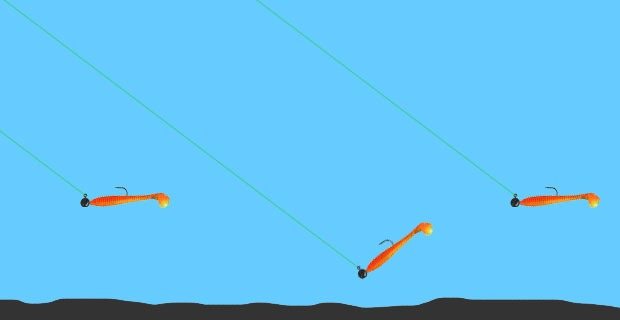
Some soft baits, when falling, perform interesting oscillations, playing with their limbs and the entire body. So, it is not surprising that many bites occur during the pause.
Naturally, pauses can interrupt uniform wiring at different frequencies. In fact, pause retrieving is the simplest type of step retrieving, when only the reel is involved, and the rod is not involved in the animation process. So, you can interrupt the rotation with the handle, literally, twice per full revolution, or you can make one or two pauses during the entire wiring.
Also, the duration of pauses in wiring may vary. The bait may only sink a little, or it may completely fall to the bottom and lie there for a little longer until the fish comes up.
So, already with such a simple retrieve as a uniform retrieve with pauses, you can change the game very widely, just by controlling the duration and frequency of pauses.
Retrieving irregularly along the bottom . You can move the bait not only, and not so much, by rotating the reel, but by twitching and tossing the rod. We cast it, let the bait fall to the bottom (the cord sags, or we hear the weight touching the bottom tactilely, “in the hand”). We take out the slack, if there is any. We make a slight upward swing with the rod, lifting the bait from the bottom. Then, pause. We pick up the slack with the reel, and the bait, having reached the top point of the jump, falls to the bottom again. Such jumps can be sharp or smooth, occur with greater or less frequency, and the height and length of the jumps may differ. In the end, you can do whole series of twitches in a row. Two or three twitches, then a pause. You can alternate series with different numbers of jerks. One-one-one, or one, one-two, one, one-two-three, one, one, one-two.
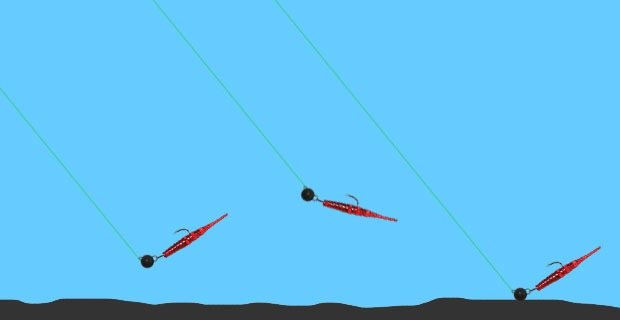
Jig rigs go very well with passive types of baits. But with active ones, with vibrating tails and twisters, this technique should also be practiced.
Wave-shaped wiring . To make the trajectory of the bait in the water column resemble a sinusoid in shape, you can use two techniques. One is the smooth lowering and raising of the tip of the spinning rod during uniform reeling with the reel. The second is a change in the speed of rotation of the coil, with the tip in a stationary position. The rotation slows down and the bait falls down, speeds up and soars up.

This is also a good way to diversify uniform wiring. Also, this method is best with active baits - vibrotails and twisters.
Dragging along the bottom . The fish are accustomed to picking up food from the bottom of the reservoir. So, the bait lying on the bottom during a pause is good! It is also very interesting when the bait moves slowly and drags along the bottom. At the same time, the limbs of the bait and its entire body move nicely. Dragging is especially important for soft baits such as crayfish, cuttlefish, nymphs, and worms.

Of course, the drawing can simply be uniform, obtained by very slow rotation of the reel with the tip of the spinning rod lowered to the water. But, it is better to use drawing with pauses. They dragged it, stopped, dragged it again.
When dragged, the hinged weight plows the bottom, raising a cloud of suspension. So, the fish, which is focused on searching for bottom food, will notice the movement from a distance and attack the bait.
Before moving on to the description of specific wiring for different types of fish, you should give advice on how to develop the technique. It is not enough to perceive the information and go to the pond, trying to speculatively play with bait. Tests should be carried out in clear shallow water or in a swimming pool. You should test the main types of baits you use, see how each of them responds to a particular wiring.
Shaking, vibration . In addition to the techniques described above, the silicone bait can be trembled in one place. The slightest trembling of the spinning rod tip is perfectly transmitted to the bait through the sensitive cord. And it shakes normally, flutters, revives its limbs. You can simply move the bait located on the bottom, or you can include an element of trembling and vibration in the animation drawing, superimposing it on any wiring.
Posting bait for perch . Perch does not really like simple, even movement of the bait. Only twisters and vibrotails, which have a high-frequency tail action, are at least somehow suitable for catching a striped predator on a simple uniform. More successful movements of soft bait for catching perch are: uniform with frequent pauses, short, rather sharp jumps. Large perch love intermittent dragging of the bait along the bottom. The use of microvibration, small tremors with the tip of a spinning rod, is one of the important techniques when fishing, specifically for perch.
Posting bait for pike . Pike, unlike perch, on the contrary, accepts uniform bait movement very well. This does not mean that you should fish exclusively this way. But God himself ordered the use of active baits, in particular large vibrotails, and the inclusion of even stages in the wiring pattern.
Retrieving a pike should be quite smooth, measured, phlegmatic, if you like (someone will remember about twitching wobblers... but silicone is not a wobbler). So, the lighter the weight used for installation, the better. In this case, when retrieving evenly with pauses, steps, during the pause the bait will smoothly sink to the bottom - the toothy predator likes this.
So, use a “Stop & Go” retrieve on your pike, with not very frequent pauses, just a uniform retrieve, stepped retrieves and smooth long jumps along the bottom.
Posting bait for pike perch . Pike perch prefers stepwise and jumping bait movement along the very contour of the bottom. Steps, jumps, at the same time, it is better to do medium and short ones. The size of pauses needs to be adjusted, because At this point, pike perch’s taste may change. And in general, I think that pike perch is more picky and capricious about fishing than perch and pike.
Posting a silicone bait for catfish . I noticed that catfish most often attack the silicone bait during a pause, in free fall. Yes, and all the other predators mentioned in the paragraphs above also often attack the bait during the fall. But with catfish, it seems to me that this is even more critical. So, take long, long pauses when trying to purposefully catch catfish when jigging in holes.
Wiring for peaceful fish . Catching peaceful fish with a spinning rod using edible silicone, although it is gaining momentum, cannot yet be considered a fully formed direction. So, this is just a small subjective recommendation. To increase the chances of catching peaceful fish with microjig tackle, you need to use a slow, smooth retrieve, without sudden movements and hysterical trembling, which perch loves.
This is how I see the topic of choosing jig wiring and soft silicone baits.
Share with your friends:
Categories: Fishing for food · Tags: Perch, Serving, Lures, Posting, Pike-perch, Equipment, Pike
Advantages of silicone baits
Silicone bait has the following advantages over other baits:
- presented in a wide variety of shapes imitating a small fish;
- bright colors quickly attract the attention of a predator;
- the opportunity to fish all year round, regardless of weather conditions;
- you can catch a predator in a place where there is grass and small algae, provided that the installation is non-snaggy;
- ease of casting a spinning rod and hooking fish.
It is also worth noting the low cost of silicone.
How to catch pike with silicone bait
There are several ways to catch a predator. These include:
Jig fishing
This method is the most effective. It is used until the reservoir freezes. They fish from a boat in order to choose the best place and carry out the fishing efficiently and comfortably, as well as from the shore, while it is necessary to constantly move to select the right place. Fishing Features:
- from a boat - use a rod 2.4 to 2.5 m long with a fast action. Since long casting is not needed, a heavy weight is not used.
- from the shore - a spinning rod 3-3.3 m long. Use a heavy, large head.
About
Equipment and secrets
Equipment can be very different. During installation, a single (offset) or double hook with jig heads of different shapes is used. The tee is used less frequently.
Video: best ways to rig silicone baits
The choice of equipment, as a rule, depends on the fishing conditions.
The bait for catching pike should be large, from 7-8 cm. In the autumn, when the fish are voracious and store up fat for a successful winter, it is worth using large baits measuring 10-15 cm.
Tips for fishermen:
- If in a certain fishing spot the pike feeds on crucian carp, then the bait should imitate it.
- In shallow water, alternation is carried out: slow tracking along the bottom and light twitching.
- Pike are often slow, it is worth paying attention to pauses to catch it as quickly as possible.
- The length of the offset hook should be slightly less than half of the silicone nozzle.
Installation of silicone baits
There are different types of installations of silicone baits - on single, double, and sometimes triple hooks. On a jig head, the bait is simply put on the hook head first. The bait is put on an offset hook as follows: the front part of the bait is pierced with the hook, then it is moved to the eye of the hook, then the sting is inserted into the body of the bait closer to its back.
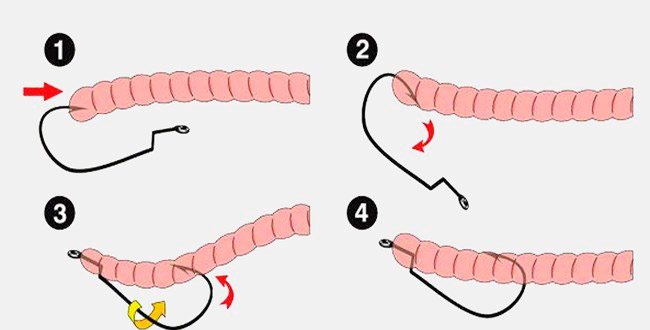
For mounting on a double, it is better to use hooks with a long shank, for example, Saikyo. The hooks are slightly moved apart, one hook pierces the side of the bait, then the hook is threaded through the body, and after both hooks are on both sides of the bait, the eye of the double is pressed through the body of the bait until it appears outward.
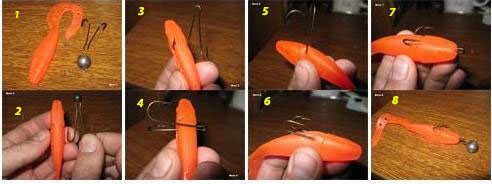
There are offset hooks with a spring attached to the eye of the hook. The front part of the bait is screwed onto the spring, then the hook tip is inserted into the body of the bait. When installing the bait on an offset hook, you must ensure that the bait, upon completion of installation, is positioned on the hook exactly as needed, and not upside down.
These types of rigs can be used when fishing with jig-spinning, retractable leash, drop-shot, Texas and Carolina rigs.
Color of silicone for pike: which one is better
The color of the rubber is chosen based on the depth at which the fish are caught, as well as the illumination of the water. Pike prefers the following colors of silicone baits:
- bright color of the bait - carrot, yellow, light green, red and other poisonous colors and their combinations, suitable for fishing at depths where there is no access to sunlight, as well as in water with low transparency;
- In good light conditions and in shallow water, muted colors are suitable. The best colors: cola, machine oil, milky gray, protective green (green pumping, watermelon), etc.
What does active and passive silicone mean?
Active baits are those that have a pronounced game of their own when they are retrieved. Such artificial baits can be used both in still (calm) water and in currents, and there are no rules for conducting the retrieve. With active silicone, it will be easier for a beginning spinner to get used to jig fishing.
Passive baits are those that do not have any activity (play) when they are immersed in water. In order to provoke the bait, you need to competently approach the issue of performing postings in various fishing conditions. Passive silicone is typically used in standing water.
Read about the variety of techniques and wiring, the rules for their implementation and other important points here
The disadvantage of passive baits is that the effectiveness of fishing with them directly depends on the abilities and dexterity of the spinning angler.
Educational video about passive silicone baits in a video from the Shcherbakov brothers
How to visually distinguish passive baits from active ones? Thus, passive baits have an external resemblance to their living prototype, while, like active ones, they have interesting tails, due to which their game occurs.
For example, like this
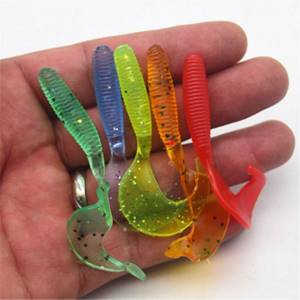
Video: How to properly catch pike with silicone
Effective and comfortable fishing is possible by choosing the right bait. Silicone bait is inexpensive and durable. Available in a variety of shapes and colors. It emits an aroma that attracts pike and has a taste that is attractive to predators. That is why many spinning anglers give their fishing preference to it.
Views: 912
Similar articles:
- How to store silicone baits, spoons and wobblers Fishing with a spinning rod involves changing baits quite often to identify the most…
- Vibrating tail for pike. Top 10 best vibrating tails for pike fishing This article will be useful to all fishing lovers, the speech in it...
- Equipment for silicone baits. How to attach silicone bait to a hook. Silicone baits are artificial baits for catching fish that...
- Offset hook: types, sizes, selection, installation The success of any fishing depends not only on the skills of a skilled fisherman...
